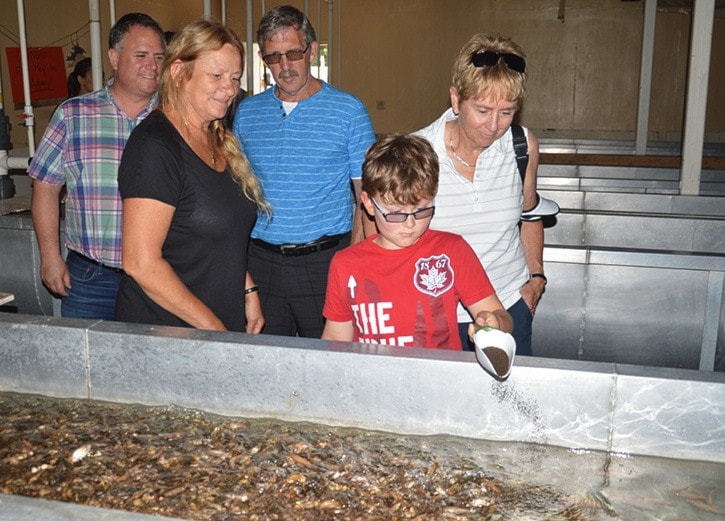Chinook salmon stocks all over the province have been depleting for decades. Where marine survival rates hit five per cent in 1982, they’ve been declining ever since.
On Vancouver Island, the problem is particularly troubling. According to a Department of Fisheries and Oceans assessment of Vancouver Island chinook in 2012, “the status of west coast Vancouver Island chinook remains poor.” Populations on south-west Vancouver Island are declining and while populations on the northwest Island are stable, they’re stable at low levels.
They also show no signs of improvement, the report reads.
With chinook stocks in trouble, Omega Pacific Hatchery owner Carol Schmitt can’t understand why her methods, which promise a higher marine survival rate, haven’t been more widely embraced by Ottawa.
“We are at five per cent or greater marine survival whereas DFO is 0.2-0.6 per cent. That’s from juvenile release to adult,” said Schmitt. Schmitt has co-run Omega Hatchery since its inception in 1987. Located on a clearing on the south-east shores of Great Central Lake, it’s run by Bruce Kenny and Schmitt.
“Our program is based on the fundamentals of natural biology,” said Schmitt. “We have low-density and high-flow, we do disease screening so we release pathogen uncompromised, unstressed fish.”
But most importantly, they get an extra year of hatchery time to grow and mature.
“In nature, a large number of chinook spend an additional year in freshwater. They develop slowly and their immune and physiological components of their body develop correctly,” said Schmitt.
Chinook with an extra year of freshwater maturation under their belts are know as S1, versus the S0 fish without that year.
“Maybe they’re not that larger than the S0s, but their behaviour’s different so they school more and they travel directly out. They don’t spend a lot of time in the estuary and they travel out as a unified group,” said Schmitt.
But Schmitt said that DFO hasn’t been so keen on adapting their methods.
“Their response was that they’ve grown yearlings numerous times before and they don’t work,” said Schmitt.
“They said that their yearling chinook came back with a large number of jacks (male fish which return sexually mature a year earlier) and the females, which would normally be four-year-olds, matured at three years old and therefore they didn’t contribute anymore to the commercial or recreational fisherman.”
DFO senior communications officer Dan Bate confirmed the less than ideal results the agency has had with yearling chinook.
“So far, experiments in producing yearling chinook at the department’s hatcheries have had mixed results in survival rates to adulthood.”
(Story continues below)

But Schmitt said Omega Pacific fish reared as S1s come back with fewer jacks and more larger, tyee salmon.
“This is what we found in our brood 2009 releases in Nahmint and Phillips rivers. There were in 2015 these larger fish returning,” said Schmitt.
The agency said it is looking into Omega Pacific’s methods.
“DFO and Omega Pacific are collaborating on a project to study the effectiveness of this proposed methodology,” said Bate.
“A study between DFO and Omega started in 2015 at Robertson Creek Hatchery. We each will be releasing 100,000 chinook smolts each year for the next four years and assess captures in the fisheries and returns back to Stamp River and Robertson Creek Hatchery,” he said.
The agency is doing six chinook salmon stock rebuilding trials this year, five of them in BC’s Interior.
But Schmitt said it’s too little, too late.
“As the scientists have weighed in, there’s no doubt about it. We’ve released over 230,000 wire tagged yearlings. The department has the majority of information and scientists have said that since they have already assessed our marine survivals at five per cent or greater, it now is time to expand it for additional streams on Vancouver Island,” said Schmitt.
If they don’t it could be too late.
“Many of our streams, like Nahmint, already have been enhanced for 35 years. They’ve released over four million S0s. Some of the releases were 200,000, 500,000, 100,000 yet it has not rebuilt the stock,” she said.
“The risk is pretty black and white. They already know what their program of releasing these millions of fish will deliver—basically very few adult returns. So you do that or you use our natural program which will deliver and increase the numbers and rebuild the stocks.”
But with over 13 years of talking to DFO gone by with no results, Schmitt is hoping that reaching out to the big fish will net her some answers.
Local, first nations and federal politicians, who toured the facility in late August, came away vowing to help.
“As far as our nation can do, we’ll whatever we can do to help and support you,” said Ucluelet First Nations President Les Doiron.
Senator Nancy Greene Raine agreed.
“The frustrations that [Omega Pacific] is facing are inexplicable to me. The knowledge that you’ve gained needs to be transferred. It really is time to shake up what’s happening,” Raine said.
“Gord [Johns, Courtenay-Alberni MP] has been talking about having some kind of inquiry into what’s happening with the chinook enhancement program on Vancouver Island. I think it’s time to do it right.”
Johns said he would use his position to work with Raine and Schmitt. “Together we’re so much stronger. We’ve got the business owner, the mayor, the regional director, the local nation—and you’ve got a senator and an New Democrat MP working together. We’re going to do some great stuff.”
reporter@albernivalleynews.com
facebook.com/albernivalleynews
